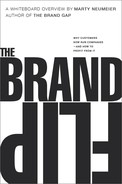RECOMMENDED READING
THE BRAND GAP, Marty Neumeier (New Riders, 2003). This, my first book on branding, shows companies how to bridge the gap between business strategy and customer experience. It defines brand-building as a system that includes five disciplines: differentiation, collaboration, innovation, validation, and cultivation. Like THE BRAND FLIP and ZAG, it was designed as “whiteboard overview”—a two-hour read that can also serve as a reference tool.
DECODING THE NEW CONSUMER MIND, Kit Yarrow (Jossey-Bass, 2014). Marketing psychologist Kit Yarrow explains how technology has rewired our brains, making us more individualistic, isolated, emotional, and distrustful. This is not a pessimistic book—it’s a practical guide to addressing customers’ desires and insecurities in a time of deep cultural shifts. Not only has she done her homework, she presents the results with lightness and clarity.
THE DESIGNFUL COMPANY, Marty Neumeier (New Riders, 2009). Forget total quality. Forget top-down strategy. In an era of fast-moving markets and leap-frogging innovation, we can no longer decide the way forward. We now have to design the way forward. The third book in my whiteboard series shows leaders and managers how to transform the organization into a power-house of brand innovation.
A SMILE IN THE MIND, Beryl McAlhone and David Stuart (Phaidon, 1998). If you buy only one book on graphic design, make it this one. Designer Stuart and writer McAlhone prove that wit is the soul of innovation, using clever and often profound examples from American and European designers, plus a few pieces from Stuart’s own firm, The Partners, in London. Look for the new 2016 edition.
TILT, Niraj Dawar (Harvard Business Review Press, 2013). This book by a professor of marketing at the Ivey Business School makes many of the same points as THE BRAND FLIP, but from a traditional business perspective. His clearly made argument is that strategic advantage is shifting from upstream activities like product manufacturing to downstream activities like brand building.
TRIBES, Seth Godin (Portfolio, 2008). More manifesto than business book, TRIBES puts out a passionate call for leaders in the age of easy group-forming. “The Web can do many things,” says Godin, “but it can’t provide leadership.” Tribes emerge when people are connected to each other, to a leader, and to an idea that matters. To the extent that brands are movements, they need great leaders.
WHO DO YOU WANT YOUR CUSTOMERS TO BECOME? Michael Schrage (Harvard Business Review Press, 2012). It’s a startling question, especially to companies that focus on their own success instead of the success of their customers. But if you’re out to build a lasting brand, it’s the right question to ask. Schrage shows why the goal of innovation should not be to invent a great product but to create a great customer.
ZAG, Marty Neumeier (New Riders, 2007). Whereas THE BRAND GAP outlines the five disciplines needed to build a charismatic brand, ZAG drills down into the first of the disciplines, differentiation. In an age of me-too products and instant communications, winning companies are those that can out-position, out-maneuver, and out-design the competition. The rule? When everybody zigs, zag.
